12 Ways to Keep Your Journal Private
You want to keep an illustrated journal as your daily art container, but you don’t want to share the nitty gritty details of your life with the public. What do you do?
“All human beings have three lives: public, private, and secret.” — Gabriel García Márquez
Happy Sunday!
It is an odd way to open a letter, but I am somehow not fancy enough for “Dear Reader,” even if it is in my head. I can’t quite pull it off.
As I sit, curled and ready for the tasks of this day, the trees are blowing out the window. The sound of the wind mingles with the rushing of cars on the wet road far below. These sounds are louder than the whirring in my ears, the ever-present hum, and not louder but closer than the fan in the bathroom, where I woke to do unexpected cleanup, teeth gritted, plastic gloves on.
I was thinking this week about who I envision as my reader (or listener), about why I am here, about why I show up, why I treat this space and practice as important. I reminded myself of some genuinely altruistic things that are deeply rooted but that I sometimes overlook. But in the end, I was left with these lines:
… but I also hold out for a reader who will find the magic in my words, who will grab the sparks in hand and toss them back into the sky, constellations forming from the moments of connection, the synapses being traced in flickering light.
It is a tenuous relationship at times, reader and writer. We both give time. We both take something away from the moment. We have different needs, hopes, desires, and reasons. That we connect, at all, and through words, is a wonderful thing.
When I sat to do my list comic for the week, it seemed empty. Visually, I am more comfortable when there is more clutter. It feels like it was a full week, but much of that doesn’t translate to the image.
Feeling the empty space as a symbol of lack is interesting. From a vantage of simplification, the image shouldn’t have more or less value based on quantity. But I feel sure lists are viewed exactly through that lens. I try to hold on to a mindset of simplification. It is hard sometimes to see the simple beauty and balance in the quotidian, hard not to wish for more or for something different. The week was full. Some things just don’t translate to the colorful boxes in the image.
I made a list of those things just now. It won’t show here. It is written in invisible ink because there are filters and walls even when it seems that this space presents an open book. The list was helpful. It helped me see all the things that did happen that the image doesn’t reflect.
The only day I went out this week, I took a walk before I went to pick up prescriptions. As I rounded the back edge of the small loop the third time, I looked at the short dirt path that leads to the canyon.
It was empty, and there was no one around me. “I should go look,” I thought. “I never do that.” I wanted to see what it felt like to stand there at that edge. As I started to walk into the small pass, a raven flew in to land on a low branch just ahead of me to my left. It stood there, still, something in its mouth, as I approached, half-afraid to walk past.
I went to the edge and looked out, and as I turned to walk back, a second raven flew in on the other side and stood on the ground. This is not the first time in recent months I’ve had a moment like this and had to walk between. I am never not afraid.
Yes, yes, random. Yes, yes, coincidence. Yes, yes, I have too much fear and worry.
Today, a set of tips, tricks, and strategies to help you control what you share from your illustrated journals. Your life doesn’t have to be an open book. You can create and record an authentic journal and control what others see.
Below:
Thank you for reading.
Amy
(This will be cut off in email because there are a bunch of images. You can click through to read the full post in the app or in a browser.)
I don't know why people are so keen to put the details of their private life in public; they forget that invisibility is a superpower.” ― Banksy
(The above audio is a voiceover only of the “12 tips and journal privacy” portion. The longer podcast version is Episode 494 of the Creativity Matters Podcast.)
When Personal Journals Are Your Art
(Note - there are a bunch of examples below. Feel free to scroll down to see the list of 12 strategies and a number of journal examples.)
So you’ve decided to keep an illustrated journal, but you don’t really want to share the details of your life with the unknown masses. It’s a really common concern. It’s a human concern.
I’m not sure most of us have masses looking at our posts, but I definitely understand the sentiment. Even one person reading your journal notes can leave you feeling a bit awkward and exposed.
I find concern over privacy to be a common theme for those of us who want to keep illustrated journals but aren’t keeping travel journals, don’t have exciting things to record day to day, and are often recording the minute details of daily living, the quotidian. I find that those of us who are struggling, who are caregivers, who are having trouble making ends meet, or balancing our moods, or staying positive, often worry more about what our journals will reveal.
Not everyone wants to shine a light on how routine days may be.
This isn’t everyone’s experience. Some people post unmasked views of every single note in their journals and planners, the good and the bad, the wins and the stumbles. Everything is there for viewers to read.
I often look at pages like that and marvel at the ability to just put it out there. I think it’s wonderful. I can’t imagine being that comfortable, that cavalier, that open. I will never be that trusting.
Sometimes I read the notes in people’s journals. Sometimes I don’t. Sometimes, I am just looking at the art, taking in the overall balance, and color, and whimsy. I assume that many people do the same and that none of us has time to read every single word that is visible in someone’s journal.
But, there is always someone, someone who zooms in, reads, makes assumptions, fills in the blanks. There is always someone who really wants to know every detail.
So what do you do?
You want to keep an illustrated journal as your daily art container, but you don’t want to share the nitty gritty details of your life with the public. What do you do?
Don’t let fear stop you from channeling your art into an illustrated journal and sharing it. If sharing your work helps you feel connected and accountable, then being able to wholeheartedly buy into illustrated journaling means adopting strategies for controlling what you show and hiding what you want to hide.
Remember, you don’t owe the public an open-book view of your life. You don’t owe followers a look at what you do every minute of the day.
You get to choose what you share and show.
Your journal should be a place you can record whatever you want to record. My illustrated journal is not the same as a free-writing or long-form journal. My illustrated journal is a short-form record, but it is also a balance of art and words. My notes tend to be abbreviated, but I do include notes about each day. The notes are not always pretty, but they are part of what grounds my pages in a specific point in time. These are the notes from the week juxtaposed with assorted drawings that come from the same span of days.
Write and draw what you want. Be intentional about taking steps to conceal what you don’t want to share.
Ready to Share Your Illustrated Journal?
When you get ready to share your work, visually scan your pages. Are there things you want or need to cover up or hide?
Here are 12 ways to control what you show when photographing and posting your work:
(I’ve included a few examples below from the last few years. Purple circles highlight sections that demonstrate the strategies covered.)
Use props. This is one of the easiest ways to conceal and interrupt the readability of your notes. Before taking a photo, identify if there are any notes you want to hide. Use small objects to physically cover them up for the photo. Put an eraser on the page. Lay a pen (or a few) across sections. Set a half-pan of paint here and there. Lay another notebook or book or your pen bag over part of the page.You control the shot.
Use small sticky notes. This has been my go-to strategy when filming my journals in the past. I go through first with a small pad of sticky notes and cover up details that I would just as soon people not pause their screens and try to read. (People will.) You can cover things with sticky notes before taking your photos, too. It works well, and if you leave them in place, then you always know where the bits and pieces are that you prefer to keep private. (Have concerns about residue and archival issues? I keep in mind that this is a journal I keep, really, for the process of doing it now. If this is a concern for you, try one of the other digital masking approaches.)
Use a photo editor and erase or cross things out. Your built-in phone editor is great for this. Open your photo, choose the markup option (in iOS), and use a pen to cross out or obscure words or lines. If you pick a color from that section of the page, you can often do this fairly subtly, more the appearance of smudging or erasing. You may find that you only need to cross a few bits out here and there to accomplish the task of hiding important details or interrupting readability. (Tip: Duplicate your photo first and make edits on the copy so that you retain a clean, unedited copy.)
Use an app to add blur. I haven’t found a good free option for doing this in a way that visually works for me, but there are paid apps, and some people successfully use blur to retain privacy. To try this, you can use the free Snapseed app and experiment with the “lens blur” feature. (Note: This doesn’t allow individual “spot blurring” the way other apps may.)
Use washi tape. Before taking a photo, lightly place a piece of washi over parts of the page that you want to conceal. (I have done this, but I tend to have issues with washi tearing my paper.) Make sure you know how your paper reacts. If you plan to pull the washi up right away, don’t press it down too hard. (Tip: Some washi is so thin and transparent that you may need more than one layer.
“Tip in” other layers. Using tip-ins is a common approach when we want to include something else without fully gluing it down and works well when we want to add another page or layer. But you can also strategically place a tip-in to help conceal your notes for a photograph. Try a magazine page, a torn book page (turn it into blackout poetry), or an index card on which you draw something else.
Create doors and windows. Similar to tip-ins, you can create small liftable windows or doors that can be down (or closed) when taking a photo but can be lifted when reading in person.
Use symbols. While not fool-proof, you can get some distance and privacy by using symbols for people or problems. Make sure you keep track of what/who your symbols stand for! (Tip: Make a cheat sheet you tuck in the back or record a “legend” or “key” on the back page or inside cover.)
Use code. This is similar to using symbols but takes it a step further. Some people come up with elaborate systems to encode their writing. You might think of Da Vinci’s reverse writing. I saw an artist here on Substack who has written entries in elvish. I tried encoding a few years ago, doing some simple alphabet replacement, but I’m sure that if I looked back now, I wouldn’t know what was what. On the flip side, I also know that things were still relatively readable. (This is similar to how we can still read a passage full of typos or with missing letters.) Again, keep a master sheet or decoder. This is one of those strategies that has such appeal, and yet I don’t want to make it that hard for myself to write my notes or to look back later. I would rather use one of the other strategies to simply block the view in a photo.
Use the margins. When you consider the layout of your pages, you may find that it helps to keep certain kinds of notes on the periphery. This makes it easier to control the photos later. It doesn’t mean you can’t have notes in more central locations, but you can think about what you are writing when you sit with your journal and decide if it will be easier to put it on an edge from the start.
Zoom way out. I don’t have a (clean) space large enough to make this work, but you will see many journal photos that are taken from a distance. This can make it harder to clearly read the text, but you’ll need to check to see how clear things are when people zoom in on the image to get closer. This isn’t foolproof and also creates such literal distance from the journal that you may not like it, but it can work.
Be clever with your photos. It seems really obvious, but it’s true. One of the best ways to control your privacy is to control what’s in the photo. Shift your angle. Rotate the book. Cut off edges that don’t need to be included. Again, you don’t owe viewers an unmitigated look at your journal. (Note: This strategy works for the periphery. Concealing things in the middle requires doubling up with some of the other strategies on the list.)
These are all simple strategies you can keep in mind. Maybe they relieve some of the anxiety associated with “sharing your journal.”
If what you really want is someone to “know” what you are going through, you probably won’t do as much deliberate masking. That’s okay. But don’t be surprised when people do read closely. At the same time, don’t be surprised when people don’t read closely.
This opens the door to many related conversations about the mindset for an illustrated journal, conversations for other days.
Ultimately, sharing journals opens you up to a voyeuristic tendency and a natural curiosity that viewers have. They want to know you better. Journals are seductive in that way. They let others take a peek into the day to day of someone else.
But, you also don’t know and can’t always control who will see your pages.
Just remember, you have control of how much viewers see. You don’t have to feel exposed to really make the illustrated journal your creative home and still feel comfortable sharing and being a part of the community.
Your Perspective
(Please note: poll responses are anonymous.)
More Examples
It wasn’t hard to find examples of these kinds of strategies as I scrolled back through my photos app. In almost all of these examples I have controlled the framing of the photo, cutting off parts (or all) of the margins.
Poll Results from Last Week
Thank you to those who voted last week.
(These are screenshots of the results. I don’t want to confuse anyone. You can’t click these.)
Given the kind of feedback I’d heard from some people, the response to the question about voiceovers surprised me. That’s really good to know. Also, it seems totally nonsensical in light of this, but I am thinking of pulling my podcast into Substack and doing it all here in one place. For those who enjoy the podcast, that would probably be a good thing.
I don’t plan to change the writing side though.
Thank you to the few who are reading and commenting.
The Weekly Bits and Pieces
🎯🖋️ Week 16 prompts for your illustrated journal
Made It?
Thank you for reading.
I always invite your comments on the post. You are also welcome to play with any of the following:
Is privacy in your journals a concern for you when sharing your work?
What is your favorite strategy for concealing parts of your journal?
Name a constellation.
Choose one: minimalist in action, minimalist in spirit, middle of the road, clutterbug, clutter chaos.
Thank you to those who continue to read and support this space. It means the world.
Thank you for reading Illustrated Life. Please consider subscribing to receive the weekly email. Writers need readers, and I am grateful for every reader!
Paid options are available for those who can and want to support the substack, the podcast, and the #illustrateyourweek prompts. Subscriptions not your thing? One-time donations are always appreciated.
(Tip: If it says “upgrade to paid” below, you are a free subscriber.)





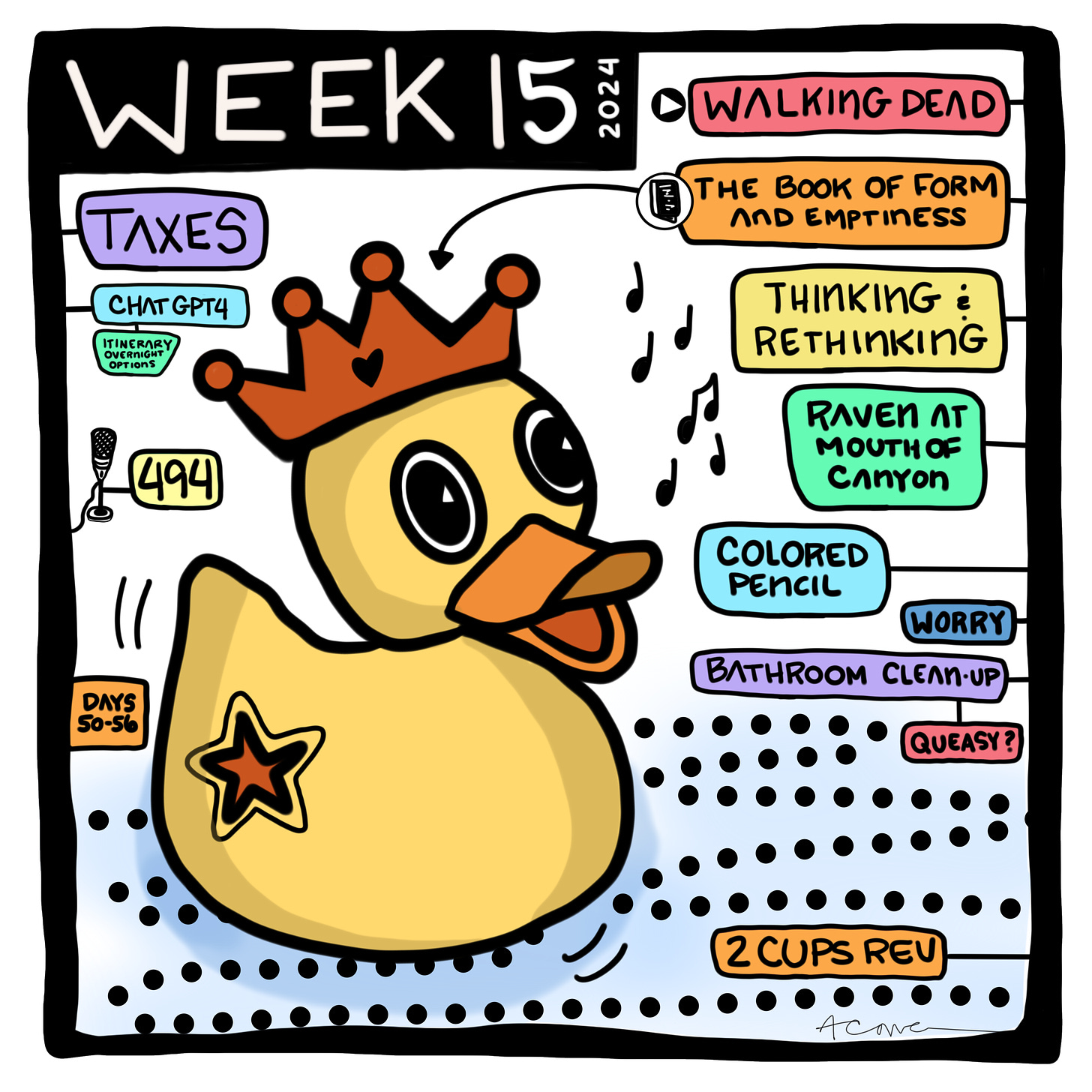
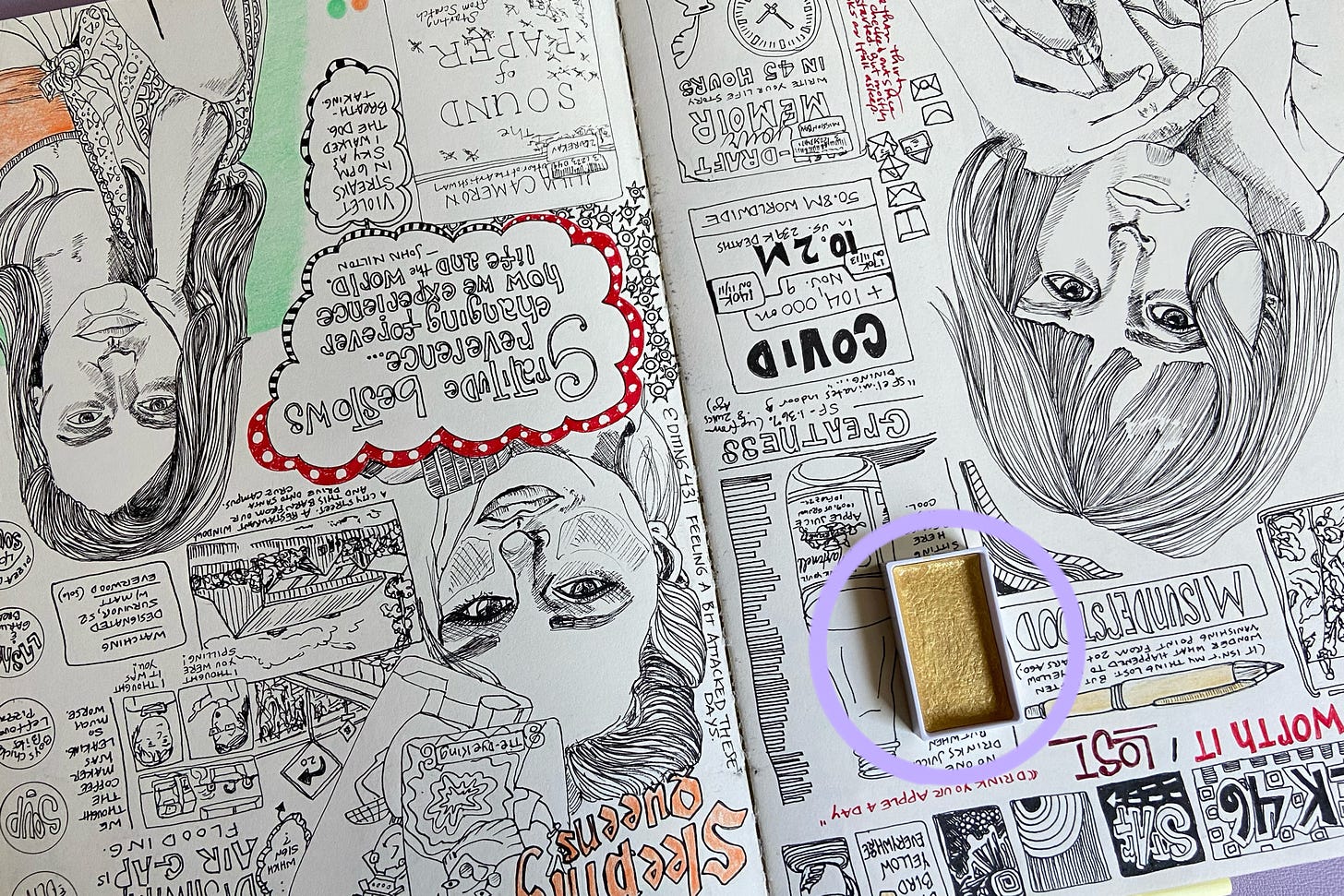

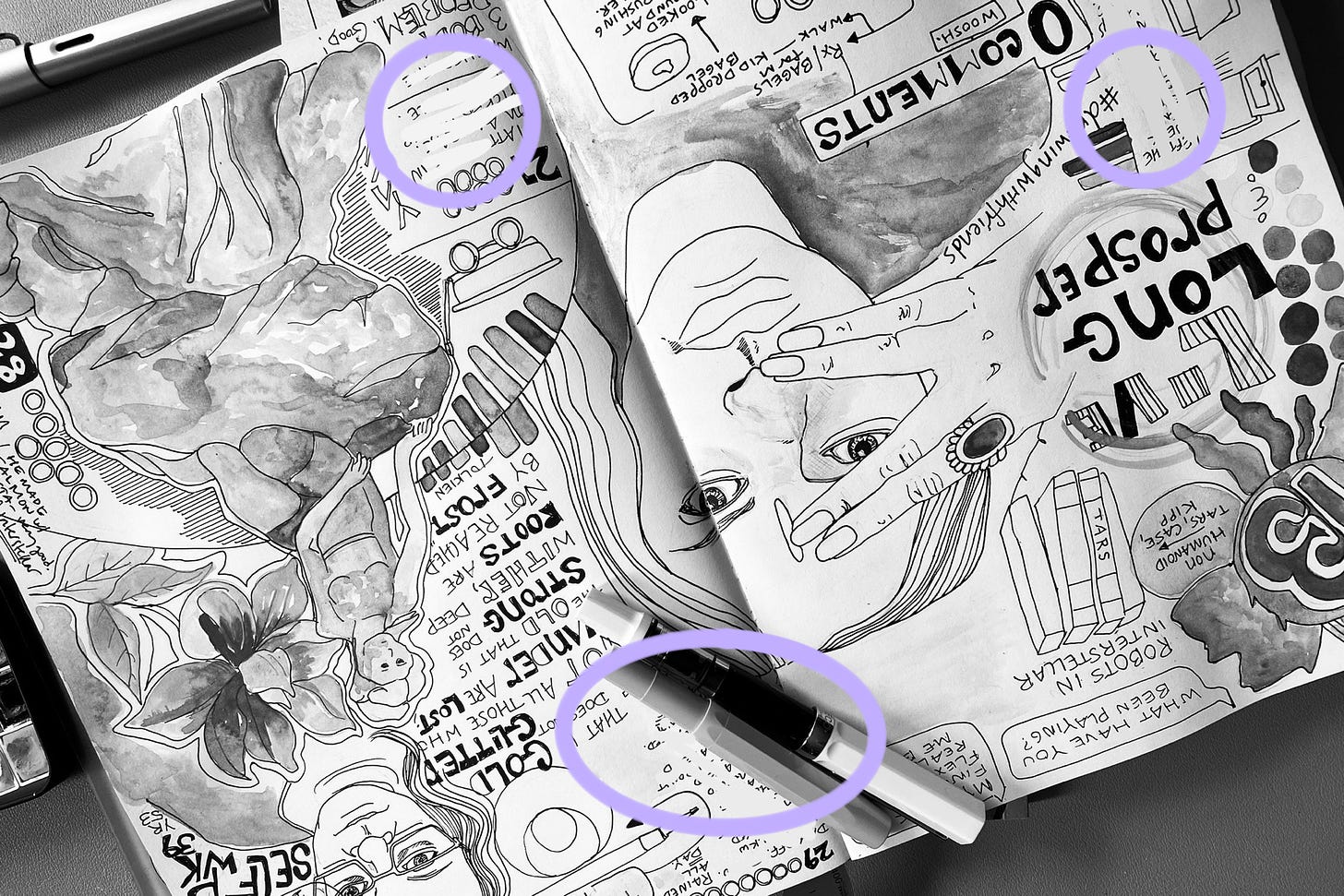
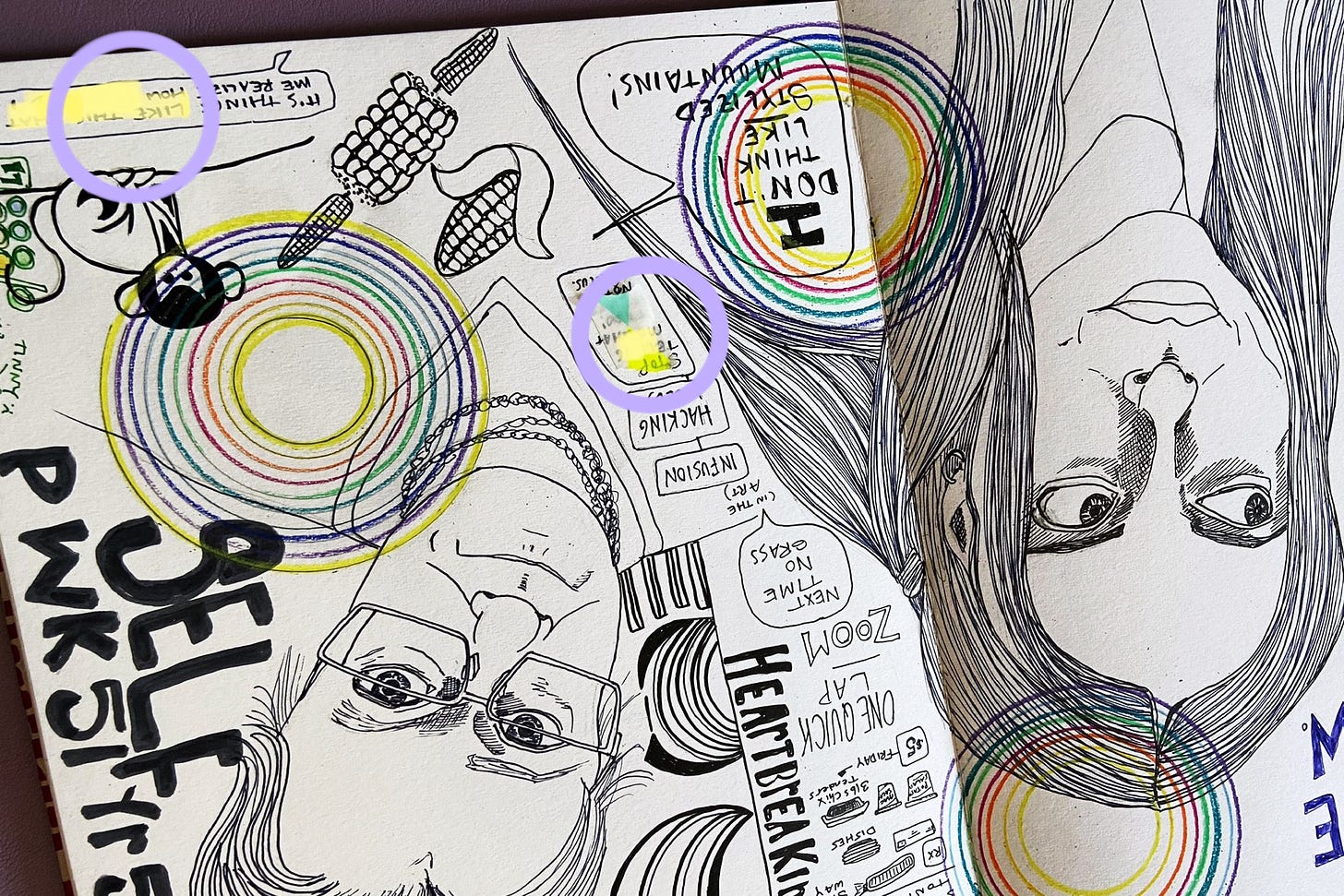
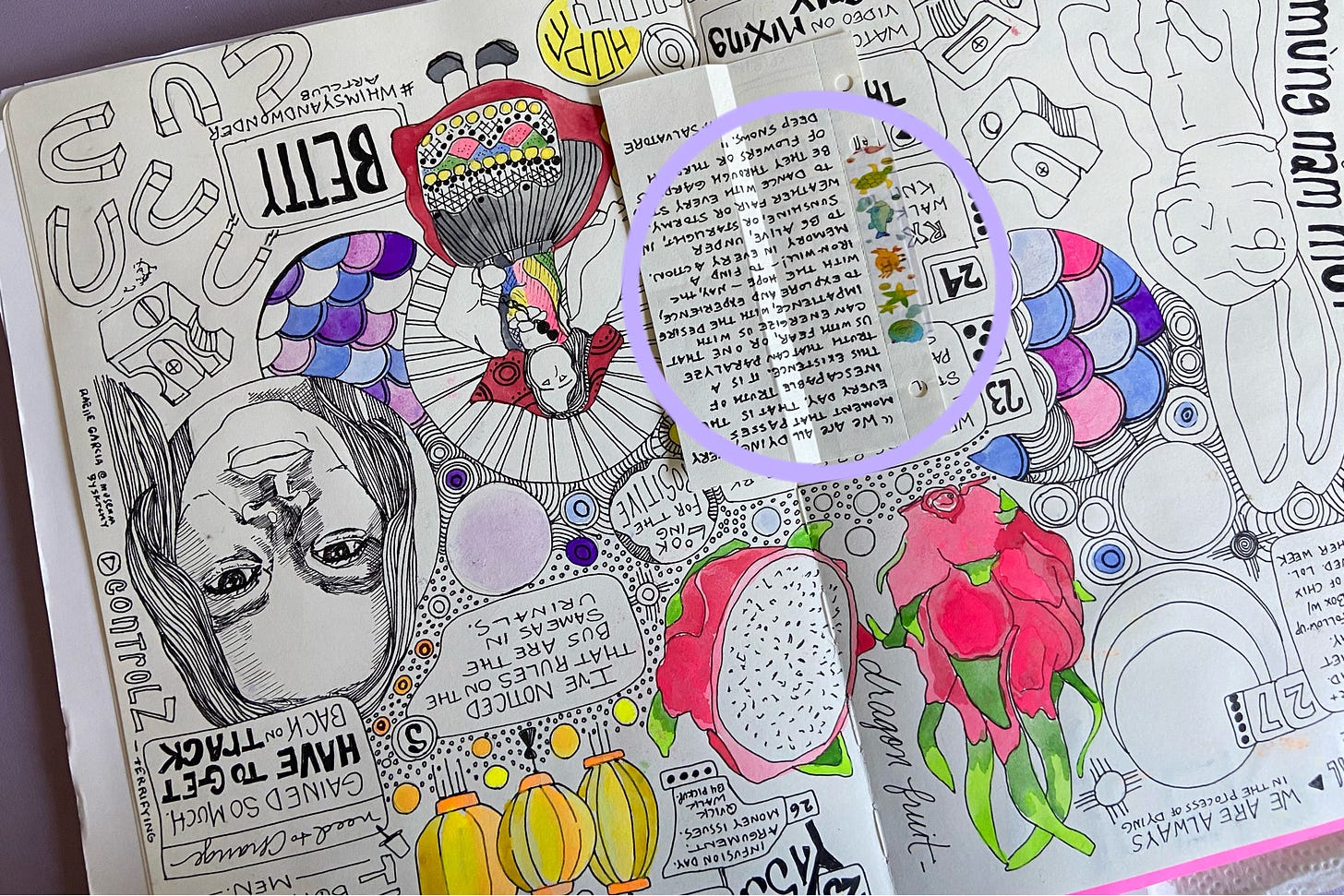
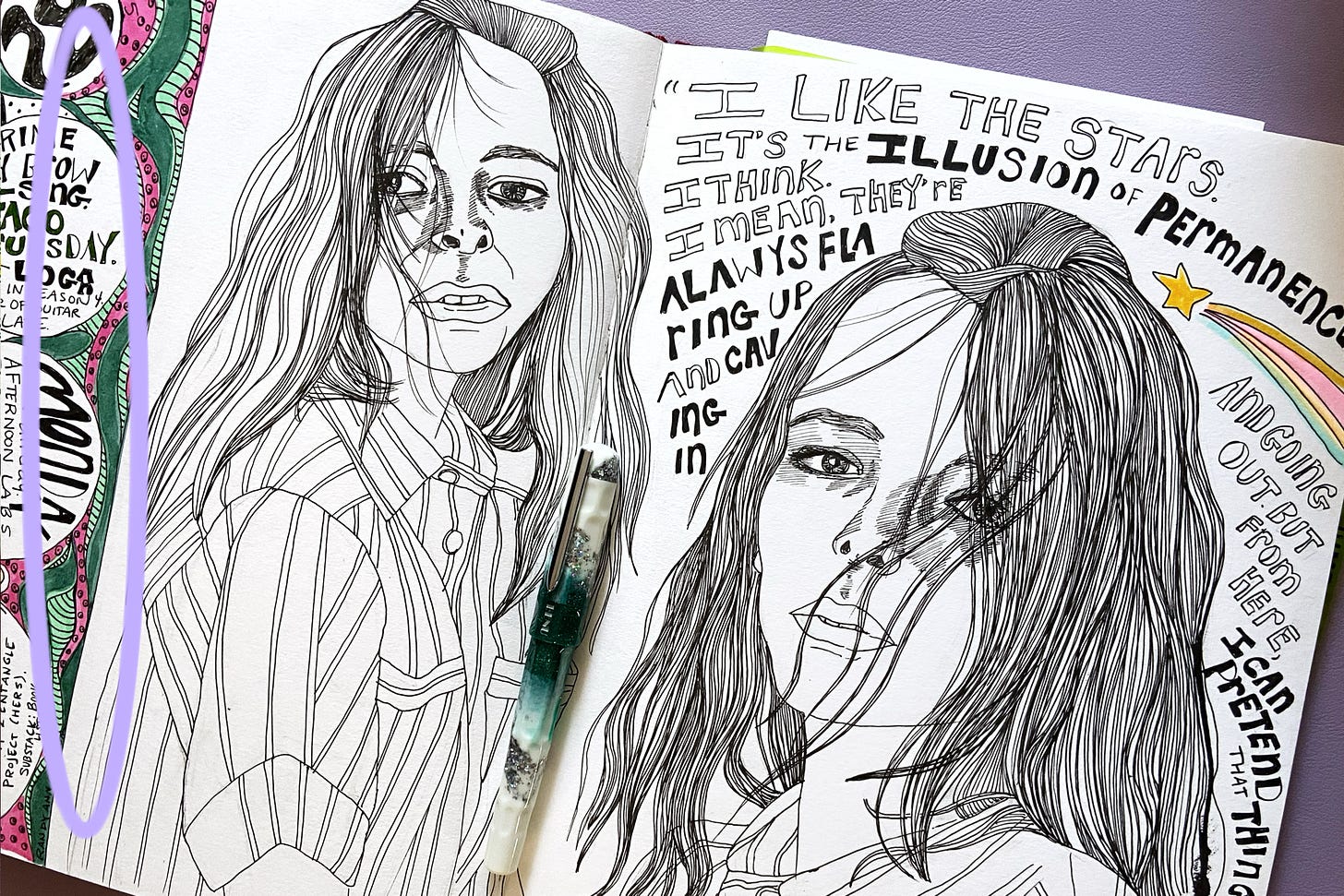
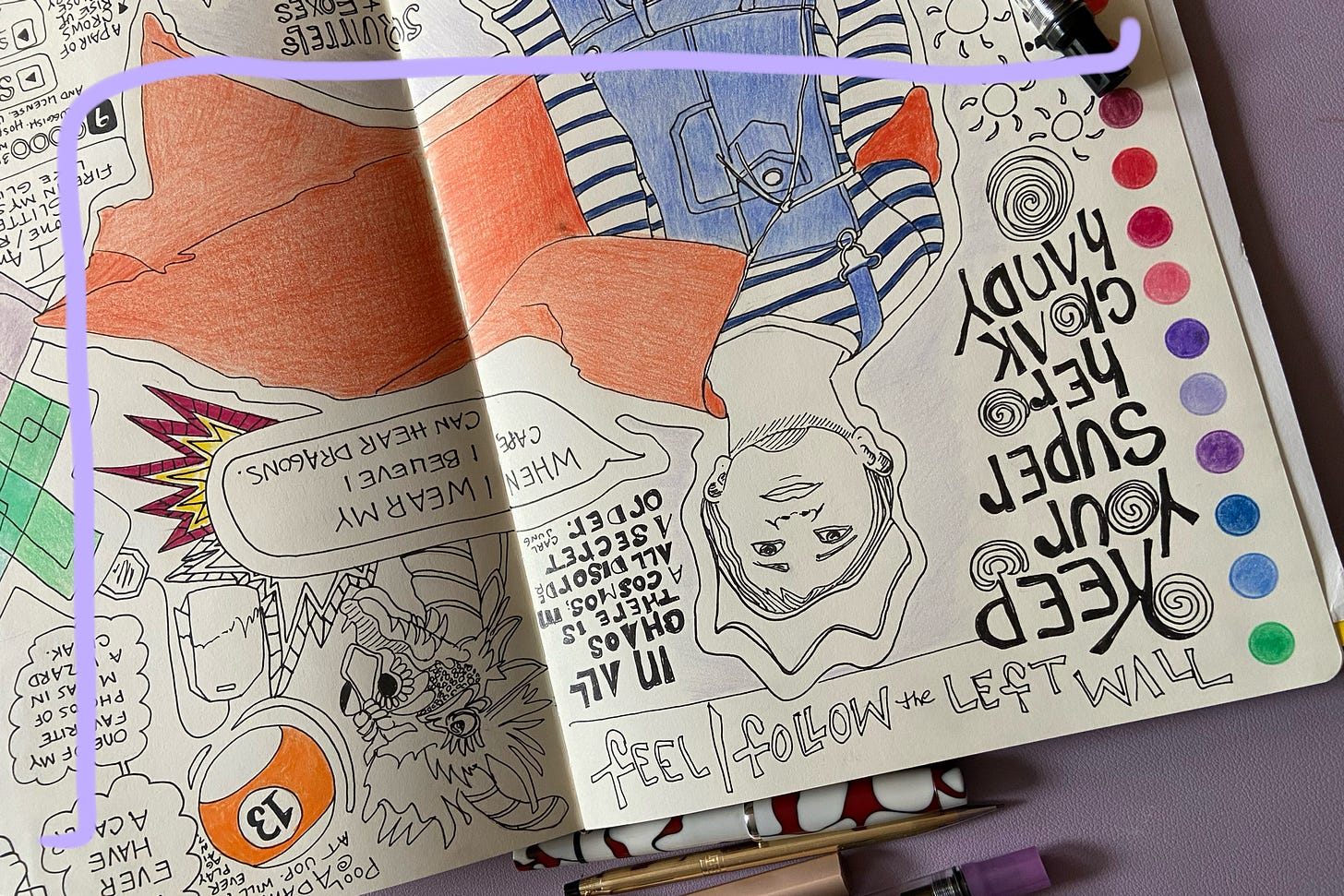
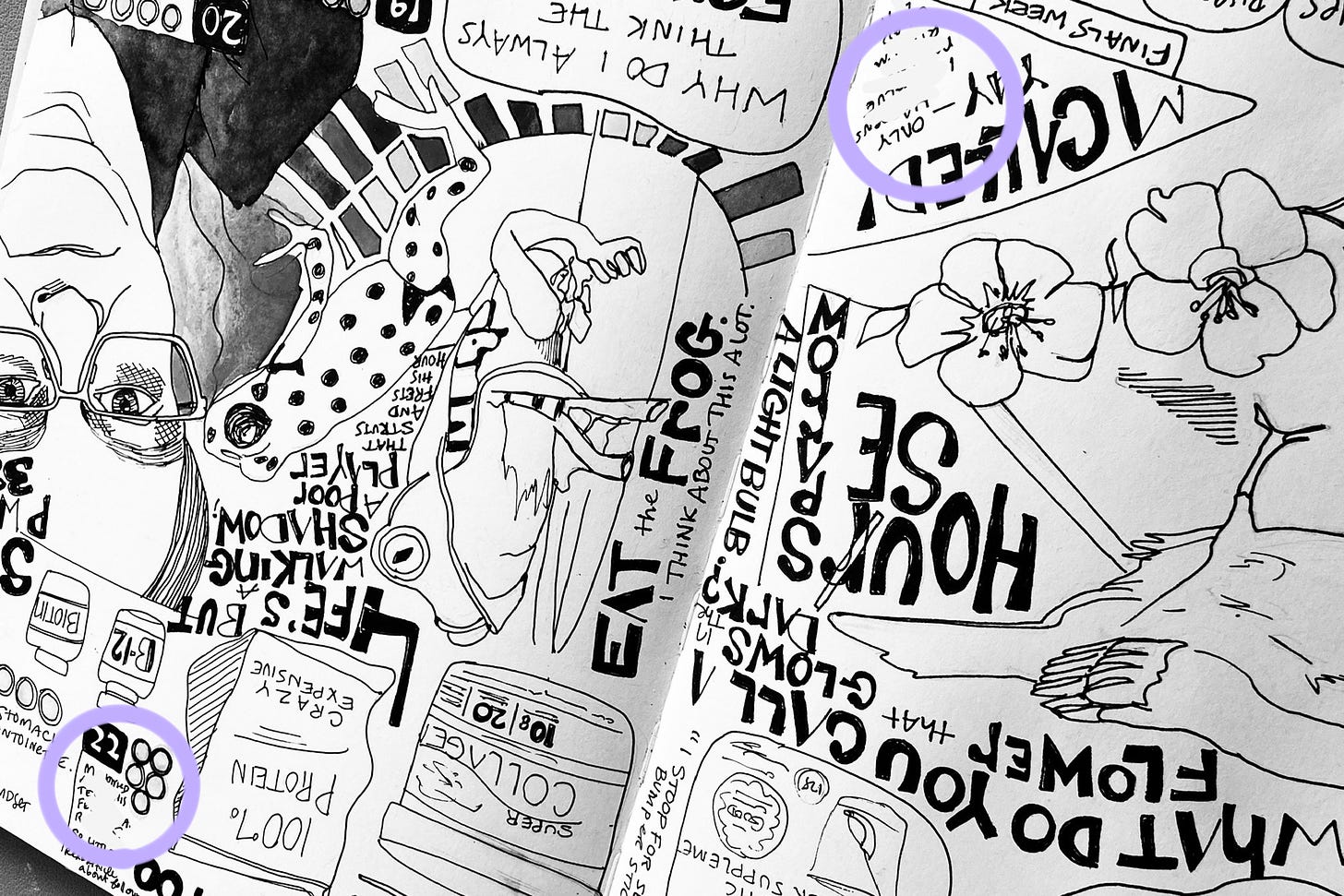



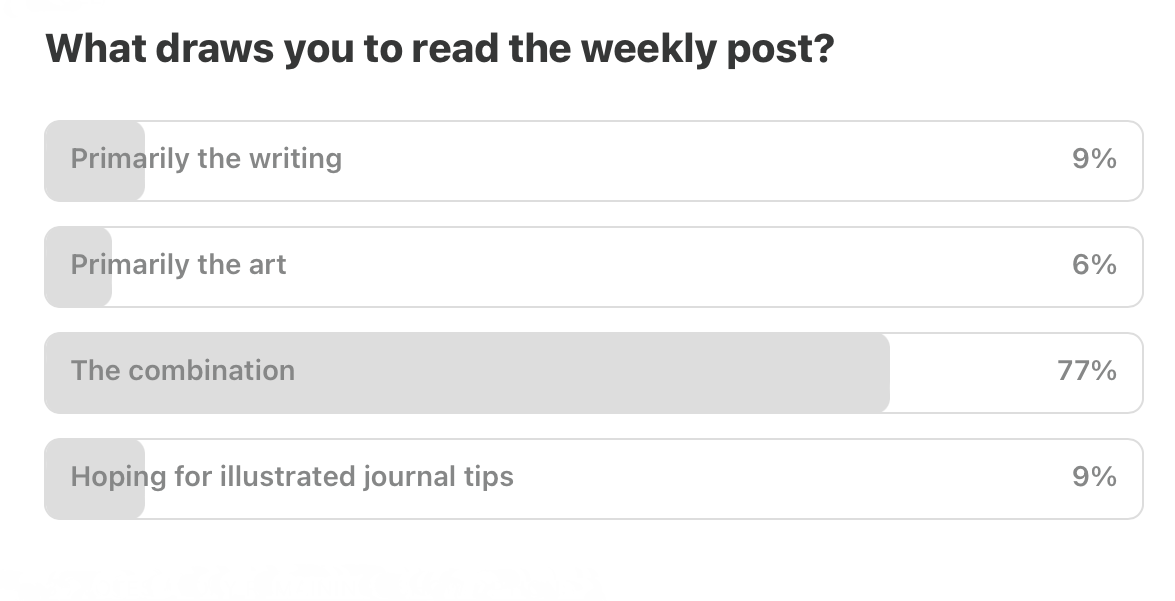
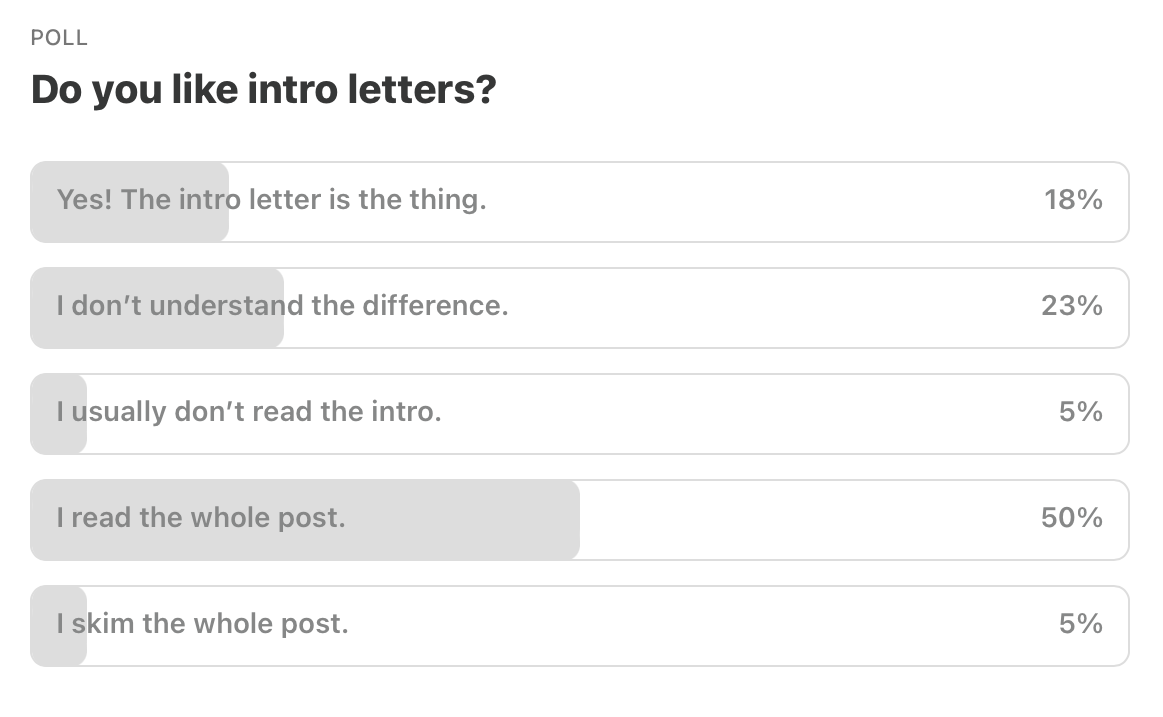
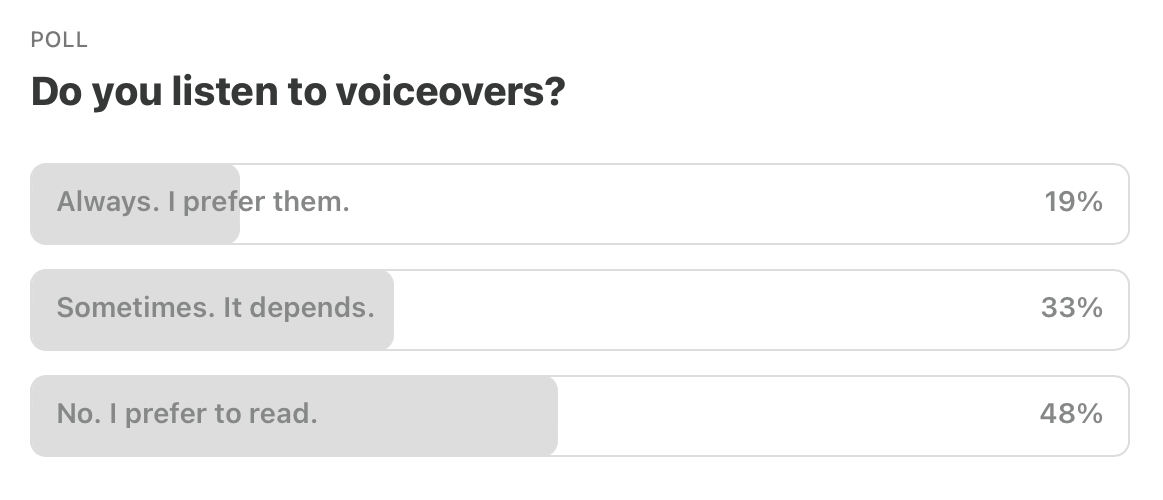
I can’t choose one. Minimalist goals, middle of the road in spirit, chaos clutter in action. I think some people, when faced with things in life they can’t control, will control the things they can. I have been steamrolled by uncontrollable chaos, and have temporarily given up.
Although the big and Little Dipper and always visible in Texas, I prefer Orion.
I struggle with a few privacy concerns with my journal.
- Authenticity is my goal. It’s good practice for me, and I hope anyone reading will feel less alone.
- There are people I do not want to share all the things with. These are actually people I know well, but I think might be hurt/offended by what I write/draw, even if that wasn’t my intention. This has been an issue in the past, and I would prefer to avoid a repeat.
- I want to respect my kids’ privacy, but our lives are really entangled and it feels impossible to tell my story without revealing theirs.
I’m uncomfortable admitting this after reading your post, but I am that person who tilts and zooms to try to find the spoken and unspoken in pages I find interesting and mysterious. My interest isn’t judgmental, and it definitely isn’t prurient, I am just genuinely curious about people’s lives (and everything else on the planet).
Interestingly timed post… the whole privacy issue and sharing is what has had me frozen of late. Which is strange because I used to write openly but as I progress through the years, I worry more and have turned entire blogs to draft simply because I felt too exposed.
Doing the illustrated week is good for me to find that balance between what I’m comfortable with sharing and what I’m not. But I do struggle because I’m a wordsmith pre artist, my pages feel unfinished or unbalanced without words so I am mostly sharing them half finished.
This has to be the longest I’ve ever stuck with any project though so I’m hoping I find that happy medium soon 🫣😂
Love the added ideas for privacy. Love to read your posts each week!